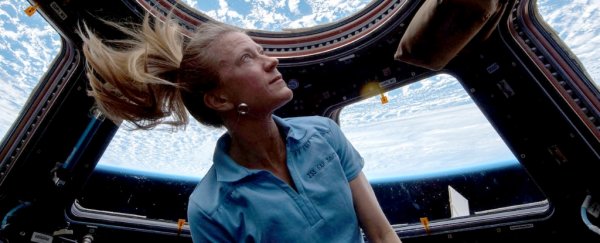For the last twenty-some years, the International Space Station (ISS) has seen hundreds of astronauts come and go. Yet even after all these years, a little part of each visitor remains, like a signature in the station's guest book.
The most extensive microbial inventory to date has now found an astonishing diversity of germs on board the ISS, and most are from humans, potentially going back to the very first visitors.
A veritable smorgasbord of bacteria and fungi, this ever-growing, ever-changing community has the microbial fingerprint of a gym, hospital or office. Just like any other communal space in which humans find themselves, it too could pose a threat to our health.
Microbes are everywhere here on Earth, and not all of them are bad, but some of those discovered on board the ISS, including Staphylococcus and Enterobacter, are known to be opportunistic, sometimes causing infections in humans.
"Whether these opportunistic bacteria could cause disease in astronauts on the ISS is unknown,' says one of the study authors, Aleksandra Checinska Sielaff, a microbiologist at Washington State University.
"This would depend on a number of factors, including the health status of each individual and how these organisms function while in the space environment."
Microbes are known to survive in extreme environments, and space is pretty challenging. Even within the sealed system of the ISS, these germs are subjected to microgravity, radiation, elevated carbon dioxide, and the recirculation of air through HEPA filters.
As humans are aspiring to venture farther out into space, it's important for us to understand what happens with our germs out there.
"This is even more important for astronauts during spaceflight, as they have altered immunity and do not have access to the sophisticated medical interventions available on Earth," says co-author Kasthuri Venkateswaran, a microbiologist at NASA's Jet Propulsion Laboratory.
Sampling the surfaces in eight locations throughout the ISS, including the viewing window, toilet, exercise platform, dining table, and sleeping quarters, the extensive study measured the station's microbial community over the course of 14 months.
What they found was a thriving community of microbes, but while the fungal groups were relatively stable over time, the bacterial groups appeared to fluctuate along with the ever-changing crew.
At 26 percent, the most prominent bacteria was Staphylococcus, followed by Enterobacter at 23 percent and Bacillus at 11 percent. Meanwhile, the most abundant fungi were easily Rhodotorula, taking up 40 percent of the entire community.
All four microbes are associated with infections here on Earth.
But it's not just astronaut health that the authors are concerned with. They argue that the integrity of the ISS itself should also be investigated, given that some of the microbes they found are associated with corrosion.
"In addition to understanding the possible impact of microbial and fungal organisms on astronaut health," says Camilla Urbaniak, a microbiologist at NASA's JPL, "understanding their potential impact on spacecraft will be important to maintain structural stability of the crew vehicle during long term space missions when routine indoor maintenance cannot be as easily performed."
Particularly worrisome is the fact that many of the microbes detected on the ISS are known to form biofilms - a thin, slimy layer that adheres to surfaces.
The authors explain that this could cause problems for the astronauts if they become infected, because biofilms are known to promote resistance to bacteria.
"Also, biofilm formation on the ISS could decrease infrastructure stability by causing mechanical blockages, reducing heat transfer efficiency, and inducing microbial influenced corrosion," the authors add.
This study has been published in Microbiome.
